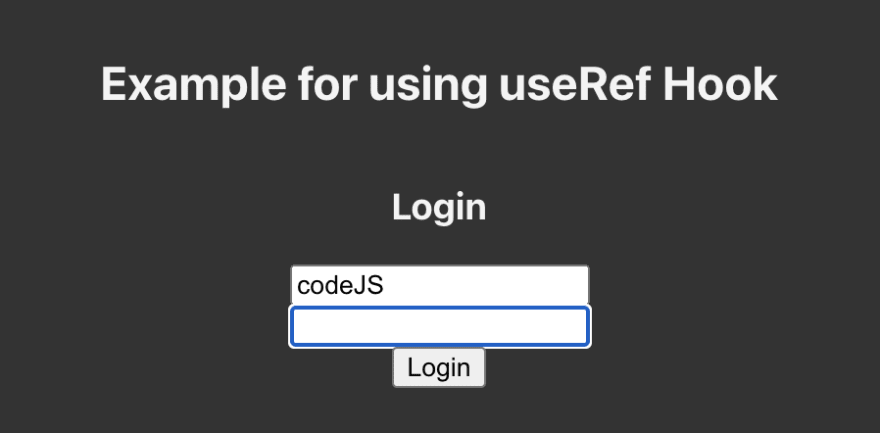An Interest In:
Web News this Week
- April 1, 2024
- March 31, 2024
- March 30, 2024
- March 29, 2024
- March 28, 2024
- March 27, 2024
- March 26, 2024
Understanding the use of useEffect hook & forwardRef in React
The useRef hook in react is used to create a reference to an HTML element. Most widely used scenario is when we have form elements and we need to reference these form elements to either print their value or focus these elements etc.
So the {useRef} hook is imported from "react" like other react hooks and we use them inside functional components to create references and this can be assigned to an html element in the jsx by using the "ref" attribute.
An example for using the useRef hook is shown below-
import React, { useEffect, useRef } from "react";const UseRefHookExplained = (props) => { // Creating refs for username and password const userNameRef = useRef(null); const passwordRef = useRef(null); // We are also creating a reference to the Login button const submitBtnRef = useRef(null); // useEffect to set the initial focus to the user name input useEffect(() => { userNameRef.current.focus(); }, []); // This function is used to handle the key press. // Whenever user hits enter it moves to the next element const handleKeyPress = (e, inputType) => { if (e.key === "Enter") { switch (inputType) { // Checks if Enter pressed from the username field? case "username": // Moves the focus to the password input field passwordRef.current.focus(); break; // Checks if Enter pressed from the password field? case "password": // Moves the focus to the submit button submitBtnRef.current.focus(); e.preventDefault(); break; default: break; } } }; // Function to handle the submit click from the button const handleSubmit = () => { alert("submitted"); }; // getting the style as prop from the parent. // Basic style to center the element and apply a bg color const { style } = props; return ( <div style={style}> <h2>Example for using useRef Hook</h2> <h3>Login</h3> <input type="text" name="username" ref={userNameRef} onKeyDown={(e) => handleKeyPress(e, "username")} /> <input type="password" name="password" ref={passwordRef} onKeyDown={(e) => handleKeyPress(e, "password")} /> <button ref={submitBtnRef} onClick={handleSubmit}> Login </button> </div> );};export default UseRefHookExplained;So the concept of useRef hook is straight forward as you can see in the above code. Follow the following steps -
- We import useRef hook from react
- We initialize this hook (eg: const inputRef = useRef(null))
- The reference created is attached to an html element using the "ref" attribute.
Now we will have a reference to this element readily available to be used to make changes like getting the value, focusing etc
Output
Initial state when the page loads - 
Focus State after entering user name and pressing enter - 
Focus state moving to the button after entering the password and clicking on Enter
So, this much should be pretty clear by now. Now let us look at a scenario when we will be using another React component for input.
In this case it becomes a little difficult to pass on the reference that we have defined in the parent component as a property to the child (Input component).
React provides us a way to handle this scenario and forward the refs to the child component using React.forwardRef
Let us check the example code to see the changes -
( I have added a comment "//new" to identify the newly added lines)
import React, { useEffect, useRef } from "react";import Input from "./Input"; // newconst UseRefHookExplained = (props) => { // Creating refs for username and password const userNameRef = useRef(null); const passwordRef = useRef(null); // We are also creating a reference to the Login button const submitBtnRef = useRef(null); // useEffect to set the initial focus to the user name input useEffect(() => { userNameRef.current.focus(); }, []); // This function is used to handle the key press. // Whenever user hits enter it moves to the next element const handleKeyPress = (e, inputType) => { if (e.key === "Enter") { switch (inputType) { // Checks if Enter pressed from the username field? case "username": // Moves the focus to the password input field passwordRef.current.focus(); break; // Checks if Enter pressed from the password field? case "password": // Moves the focus to the submit button submitBtnRef.current.focus(); e.preventDefault(); break; default: break; } } }; // Function to handle the submit click from the button const handleSubmit = () => { alert("submitted"); }; // getting the style as prop from the parent. // Basic style to center the element and apply a bg color const { style } = props; return ( <div style={style}> <h2>Example for using useRef Hook</h2> <h3>Login</h3> {/* New. Using the Component instead of input element */} <Input type="text" name="username" ref={userNameRef} onKeyDown={(e) => handleKeyPress(e, "username")} /> {/* New. Using the Component instead of input element */} <Input type="password" name="password" ref={passwordRef} onKeyDown={(e) => handleKeyPress(e, "password")} /> <button ref={submitBtnRef} onClick={handleSubmit}> Login </button> </div> );};export default UseRefHookExplained;Now let us look at the Input.js component
import React from "react";/* In the functional component, a second argument is passed called ref, which will have access to the refs being forwarded from the parent */const Input = (props, ref) => { /* assigning the ref attribute in input and spreading the other props which will contain type, name, onkeydown etc */ return <input {...props} ref={ref} />;};// wrapping the Input component with forwardRefconst forwardedRef = React.forwardRef(Input);// Exporting the wrapped componentexport default forwardedRef;So, React.forwardRed provides us a way with which we can still pass on or forward the refs defined in the parent component to the child component.
Hope you learned something new today!
Original Link: https://dev.to/sajithpradeep/understanding-the-use-of-useeffect-hook-forwardref-in-react-57jf
Dev To
 An online community for sharing and discovering great ideas, having debates, and making friends
An online community for sharing and discovering great ideas, having debates, and making friendsMore About this Source Visit Dev To


